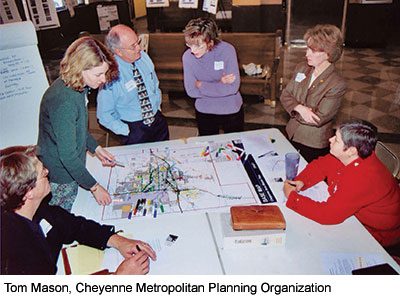Recently, several of us in the planning staff in the Rocky Mountain Region here in Lakewood, Colorado went a few miles down the road to visit the Denver Service Center of the National Park Service. This center has a planning staff, which enters into an agreement with each Park Service Region and individual Park Service units to do a general management plan for each Park unit. The advantages of this approach are the organizational efficiencies from having a trained professional staff in a centralized location. There are some disadvantages such as travel costs, etc., and there appear to be some budget battles between the Service Center and the Park Service regions that sometimes have their own planning personnel. What’s also interesting is that some parks (notably Yellowstone) have refused to do a general management plan, preferring a local planning approach for each area of the Park. Overall, however, there are many lessons from the Park Service planning model that might be useful for the Forest Service. Here is the Park Service planning website.
Here are some further thoughts from Dave Loomis, a regional environmental coordinator on our staff, who also attended the meeting, about an intriguing issue – how much simpler the overall Park Service planning direction appears to be when compared to the Forest Service, and how the guidance sets the stage for planning that is less costly and more efficient.
Forest Service planning is in a state of disarray because it costs too much and takes too long. The agency is currently operating (indirectly) under planning regulations from the 1970s, a time when most of the planning profession was operating under the theory of “rational comprehensive” planning. This theory held that we solve a huge comprehensive list of land use issues by studying them really hard, conducting extensive inventories, and applying rational scientific problem solving models. Sounded great, but did not work. It was too expensive, too time consuming, and did not reflect the reality that land use planning is largely a political process.
Nationwide, the planning profession has moved beyond the old rational comprehensive model towards more efficient, more effective collaborative processes that are extremely difficult to codify in a detailed ordinance or regulation. For example, the National Park Service has a very simple regulatory structure that allows it the flexibility to develop Park general plans efficiently and effectively. The average cost of a Park Plan is $700,000 compared to $2,000,000 for a Forest Plan. Yes, the Park Service mission is more focused and its plans deal with a narrower range of controversies, but its recreation vs preservation controversies are every bit as intensive as any controversy facing a Forest Service plan. Yet, the Park Service is able to complete its plans at a fraction of the cost of Forest Plans and with far less litigation. Simple, straightforward planning directives contribute to this effectiveness. By contrast, the complex Forest Service rational comprehensive planning regulatory structure has contributed to our lack of effectiveness. Think Windows 7 simplicity vs Windows Vista complexity.
OK here’s two caveats. One, Park Service efficiency is not solely the result of its streamlined directives. The Park Service has also developed business models that also contribute to planning effectiveness. However, the ability of the Park Service to develop innovative business practices is related to its less prescriptive directives. Two, the Park Service plans do not solve many land use issues on many of the Parks. They are not all things to all people. Some tough decisions are made during program, project, or site specific planning. There are clearly tradeoffs to be made in developing planning hierarchies.
That said, it’s important to consider efficiency and effectiveness as the Forest Service continues to update its planning regulations. The agency should focus on successful planning structures developed by other federal, state, and local land use planning agencies. The fact that the Park Service’s simple regulatory structure has contributed to its ability to develop plans at a fraction of the cost of Forest plans cannot be ignored.






